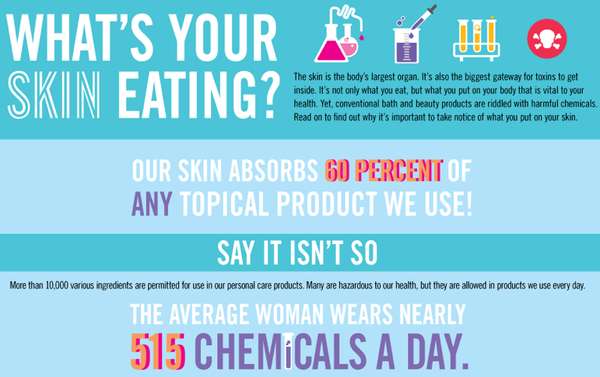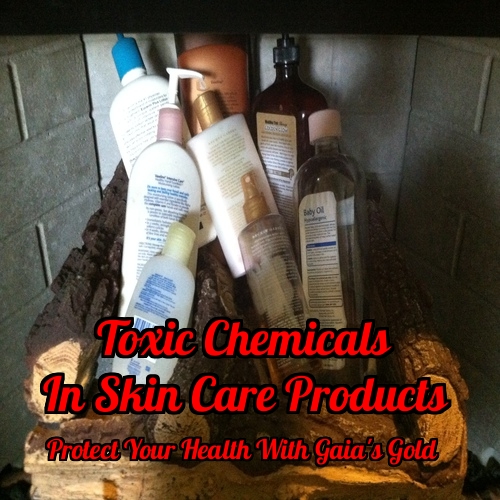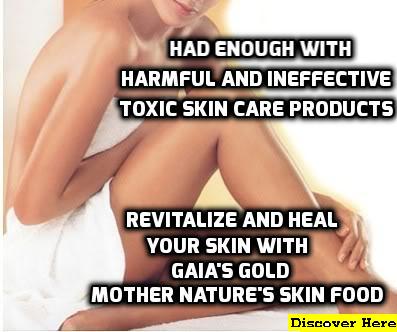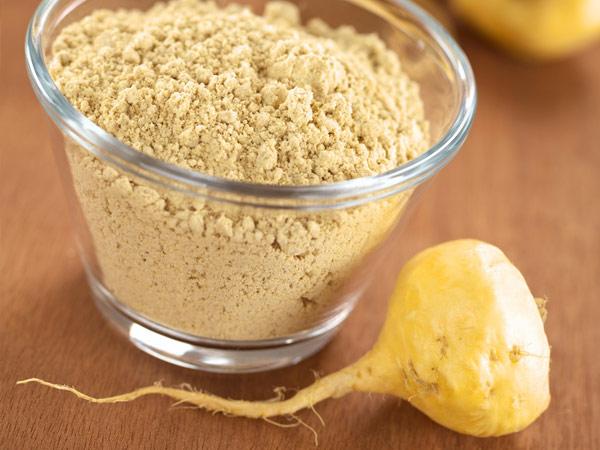Most people are not aware just how dangerous the commercial name brand personal, skin care and cosmetic products they use are. Many of these chemicals have been found to cause cancers, premature aging, and MORE! You are probably quite familiar with dermal patches placed on the skin such as nicotine and birth control patches, right? Then you already understand the wonderful power of your body’s largest organ, Your Skin! Thankfully, our skin is able to hold in everything that goes on in the inside of our body :). Just like with any dermal patch, our skin also absorbs much of what comes in contact with it, whether chemicals or nutrients. It is just as important to read the labels on your Skin Care Products as it is your Food and Beverage labels.

“Your skin is designed to protect you from countless insults: from air pollution to murky lake water… your skin’s cells aren’t as tightly packed as real bricks, though, which means things can squeeze by and penetrate.” That’s good news if you want, say, an anti-itch product to tackle that exercise-induced rash on the skin of your inner thighs. Bad news when strong chemicals meet sensitive or thin skin, the chemicals cause an allergic reaction and dangerously flood your bloodstream. “
Francesca J. Fusco, M.D., assistant clinical professor of dermatology at the Mount Sinai School of Medicine.
http://edition.cnn.com/2008/HEALTH/02/05/healthmag.creams/index.html?iref=newssearch
Let’s explore what some of the toxic chemicals are that are found in many of maybe your daily Skin Care Products.
This includes lotions, face and body washes, toothpastes, deodorants make up, perfumes, oils and even baby products.
To prepare grab any body, face and/or skin care product you or your loved ones use, and take note of any chemicals mentioned. At the end share your thoughts in our quick poll and express just how many chemicals are harming you and your family!
“Different products mean different levels
of toxic exposure and concern.
For instance, if you use a lotion that
contains toxic ingredients
all over your body, it soaks into your skin
all day. You’re getting a lot more exposure
to those chemicals than if you were to use
the same ingredients in a face cleanser that
is quickly washed off.”
Huff Post Healthy Living
http://www.huffingtonpost.com/deborah-burnes/skin-care_b_1540929.html
The following toxic chemicals were obtained from:
http://www.health-report.co.uk/ingredients-directory.htm#Home
To search chemical toxicity data visit:
http://www.hazard.com/msds/
1,4-Dioxane
- A carcinogenic contaminant of cosmetic skin care products. Almost 50% of cosmetics containing ethoxylated surfactants were found to contain dioxane. (See Ethoxylated surfactants). Dioxane may exert its effects through inhalation, skin absorption, and ingestion.Dioxane is an eye and mucous membrane irritant, primary skin irrtiant, central nervous system depressant, nephrotoxin, and hepatotoxin. Acute Exposure can causes irritation, headache, dizziness, and narcosis. Chronic Inhalation Exposure: can produce damage to the liver and kidneys, and cause blood disorders.
Medical Conditions Aggravated By Skin Exposure Preclude From Expose Those Individuals With Disease Of The Blood, Liver Kidneys, Central Nervous System, And Those Susceptible To Dermatitis.
Alcohol, Isopropyl (SD-40)
- A very drying and irritating solvent and dehydrator that strips your skin’s natural acid mantle, making us more vulnerable to bacteria, molds and viruses. It is made from propylene, a petroleum derivative. It may promote brown spots and premature aging of skin.
Anionic Surfactants
Anionic refers to the negative charge these surfactants have. They may be contaminated with nitrosamines, which are carcinogenic. Surfactants can pose serious health threats. They are used in car washes, as garage floor cleaners and engine degreasers – and in 90% of personal skin care products that foam.
- Sodium Lauryl Sulfate (SLS)
- Sodium Laureth Sulfate (SLES)
- Ammonium Lauryl Sulfate (ALS)
- Ammonium Laureth Sulfate (ALES)
- Sodium Methyl Cocoyl Taurate
- Sodium Lauroyl Sarcosinate
- Sodium Cocoyl Sarcosinate
- Potassium Coco Hydrolysed Collagen
- TEA (Triethanolamine) Lauryl Sulfate
- TEA (Triethanolamine) Laureth Sulfate
- Lauryl or Cocoyl Sarcosine
- Disodium Oleamide Sulfosuccinate
- Disodium Laureth Sulfosuccinate
- Disodium Dioctyl Sulfosuccinate etc
Butylated Hydroxyanisole (BHA)
- Dr Epstein reports in his book Unreasonable Risk this chemical is carcinogenic! Also known to cause skin allergic contact dermatitis.
Butylated Hydroxytoluene (BHT)
- Causes skin allergic contact dermatitis. Contains poison toluene.
Cationic surfactants
These chemicals have a positive electrical charge. They contain a quaternary ammonium group and are often called “quats”. These are used in hair conditioners, but originated from the paper and fabric industries as softeners and anti-static agents. In the long run they cause the hair to become dry and brittle. They are synthetic, irritating, allergenic and toxic, and oral intake of them can be lethal.
- Stearalkonium chloride
- Benzalkonium chloride
- Cetrimonium chloride
- Cetalkonium chloride
- Lauryl dimonium hydrolysed collagen
Chloromethylisothiazolinone & Isothiazolinone
- Corrosive to the skin, possibbly resulting in third degree burns. Harmful if absorbed. Causes allergic contact dermatitis in susceptible individuals. If inhaled: can be corrosive to the mucus membranes and the lungs.
Cocoamidopropyl Betaine
- Can cause skin and eye irritation
DEA (Diethanolamine), MEA (Monoethanolamine), TEA (Triethanolamine)
- Hormone-disrupting chemicasl that can form cancer-causing agents — research indicates a strong link to liver and kidney cancer. They are commonly found in shampoos, soaps, bubble baths and facial cleansers. Often used in skin cosmetics to adjust the pH, and used with many fatty acids to convert acid to salt (stearate), which then becomes the base for a cleanser. TEA causes allergic reactions including eye problems, dryness of hair and skin, and could be toxic if absorbed into the body over a long period of time. These chemicals are already restricted in Europe due to known carcinogenic effects. Dr. Samuel Epstein (Professor of Environmental Health at the University of Illinois) says that repeated skin applications of DEA-based detergents resulted in a major increase in the incidence of liver and kidney cancer . See Nitrosating agents. Product is severely irritating to body tissues and possibly corrosive to the eyes. Amines react with nitrosating agents to form nitrosamines, which are carcinogenic.
Diazolidinyl urea
- Established as a primary cause of contact dermatitis (American Academy of Dermatology). Contains formaldehyde, a carcinogenic chemical, is toxic by inhalation, a strong irritant, and causes contact dermatitis.Contact causes smarting and burning sensations, inflammation, burns, painful blisters, and profound damage to tissue.
DMD Hydantoin
- Contains Formaldehyde. See Formaldehyde
Ethoxylated surfactants
- Ethoxylated surfactants are widely used in cosmetics as foaming agents, emulsifiers and humectants. As part of the manufacturing process the toxic chemical 1,4-dioxane, a potent carcinogen, is generated. On the label, they are identified by the prefix “PEG”, “polyethylene”, “polyethylene glycol”, “polyoxyethylene”, “-eth-“, or “-oxynol-“.
FD&C Color Pigments
- Synthetic colors made from coal tar. Contain heavy metal salts that deposit toxins onto the skin, causing skin sensitivity and irritation. Animal studies have shown almost all of them to be carcinogenic.
Formaldehyde
- Formaldehyde is a known carcinogen (causes cancer). Causes allergic, irritant and contact dermatitis, headaches and chronic fatigue. The vapour is extremely irritating to the eyes, nose and throat (mucous membranes). See Nitrosating Agents.
Fragrance
- Fragrance on a label can indicate the presence of up to four thousand separate ingredients, many toxic or carcinogenic. Symptoms reported to the USA FDA include headaches, dizziness, allergic rashes, skin discoloration, violent coughing and vomiting, and skin irritation. Clinical observation proves fragrances can affect the central nervous system, causing depression, hyperactivity, and irritability.
Imidazolidinyl Urea
- The trade name for this chemical is Germall 115. Releases formaldehyde, a carcinogenic chemical, into cosmetics at over 10°C. Toxic. See Formaldehyde
Isopropyl Palmitate
- A fatty acid from palm oil combined with synthetic alcohol. Industry tests on rabbits indicate the chemical can cause skin irritation and dermatitis. Also shown to be comedogenic (acne promoting)
Lanolin
- Any chemicals used on sheep will contaminate the lanolin obtained from the wool. The majority of lanolin used in cosmetics is highly contaminated with organo-phosphate pesticides and insecticides.
Methylisothiazolinone and Methylchloroisothiazolinone
- Both cause cosmetic allergies and potential dangerous neuro-toxic effects.“While more research is needed to determine what effect MIT would have in rodent models, both at the cellular level and to a developing nervous system, our results thus far suggest there is potential that everyday exposure to the chemical could also be harmful to humans. I would be particularly concerned about occupational exposure in pregnant women and the possibility of risk to the fetus,” senior author Elias Aizenman,professor of neurobiology at the University of Pittsburgh School of Medicine, said.“As an antimicrobial agent, or biocide, MIT and related compounds kill harmful bacteria that like to grow near moisture or water and hence, often are found in personal care products, as well as in water-cooling systems, however, the research has now revealed that even a 10-minute exposure at a high concentration was lethal to the nerve cells. This chemical is being used more and more extensively, yet there have been no neurotoxicity studies in humans to indicate what kind and at what level exposure is safe. I realize it’s a big leap to suggest there may be a parallel between environmental exposure and the noticeably higher rates of diagnosed childhood developmental disabilities, but I would caution, that based on our data, there very well could be neuro-developmental consequences from MIT. Clearly, more study is needed, with both scientists and government regulators equally engaged,” Dr. Aizenman added.
Mineral Oil
Petroleum by-product that coats the skin like plastic, clogging the pores. Interferes with skin’s ability to eliminate toxins, promoting acne and other disorders. Slows down skin function and cell development, resulting in premature aging. Used in many products (baby oil is 100% mineral oil!) Any mineral oil derivative can be contaminated with cancer causing PAH’s (Polycyclic Aromatic Hydrocarbons). Manufacturers use petrolatum because it is unbelievably cheap.
- Mineral oil
- Liquidum paraffinum (also known as posh mineral oil!)
- Paraffin oil
- Paraffin wax
- Petrolatum
Nitrosating Agents
The following chemicals can cause nitrosamine contamination, which have been determined to form cancer in laboratory animals. There are wide and repeated concerns in the USA and Europe about the contamination of cosmetics products with nitrosamines.
- Cocoyl Sarcosine
- 2-bromo-2-nitropropane-1,3-diol
- DEA compounds
- Imidazolidinyl Urea
- Formaldehyde
- Hydrolysed Animal Protein
- >Lauryl Sarcosine
- MEA compounds
- Quaternium-7, 15, 31, 60, etc
- Sodium Lauryl Sulfate
- >Ammonium Lauryl Sulfate
- Sodium Laureth Sulfate
- Ammonium Laureth Sulfate
- Sodium Methyl Cocoyl Taurate
- >TEA compounds
Paraben preservatives (methyl, propyl, butyl, and ethyl)
- >Used as inhibitors of microbial growth and to extend shelf life of products. Widely used even though they are known to be toxic. Have caused many allergic reactions and skin rashes. Highly toxic.
Phthalates
- Toxic gender bending chemical used as a plasticizer in food wraps and many pliable plastics and containers. Also used in hairsprays and some cosmetics including nail varnishes from where it is readily absorbed into the system. All 289 people in a recent test for body load of chemicals tested positive for phthalates. Phthalates are implicated with low sperm counts and also causing sexual abnormalities and deformities. An in depth article on phthalates can be found on the www.health-report.co.uk website
Polyethylene Glycol (PEG) compounds
- Potentially carcinogenic petroleum ingredient that can alter and reduce the skin’s natural moisture factor. This could increase the appearance of aging and leave you more vulnerable to bacteria. Used in cleansers to dissolve oil and grease. It adjusts the melting point and thickens products. Also used in caustic spray-on oven cleaners. See Ethonxylated Surfactants
Propylene/Butylene Glycol
- Propylene glycol (PG) is a petroleum derivative. It penetrates the skin and can weaken protein and cellular structure. Commonly used to make extracts from herbs. PG is strong enough to remove barnacles from boats! The EPA considers PG so toxic that it requires workers to wear protective gloves, clothing and goggles and to dispose of any PG solutions by burying them in the ground. Because PG penetrates the skin so quickly, the EPA warns against skin contact to prevent consequences such as brain, liver, and kidney abnormalities. But there isn’t even a warning label on products such as stick deodorants, where the concentration is greater than in most industrial applications.
PVP/VA Copolymer
- A petroleum-derived chemical used in hairsprays, wavesets and other cosmetics. It can be considered toxic, since particles may contribute to foreign bodies in the lungs of sensitive persons.
Quaternium-7, 15, 31, 60, etc
- Toxic, causes skin rashes and allergic reactions. Formaldehyde releasers. Dr Epstein reports in his book Unreasonable Risk “Substantive evidence of casual relation to leukaemia, multiple myeloma, non-Hodgkin’s lymphoma and other cancers”
Rancid Natural Emollients
- Natural oils used in cosmetics should be cold pressed. The refined vegetable oils found on supermarket shelves and many health food stores which lack colour, odour and taste are devoid of nutrients, essential fatty acids, vitamins and unsaponifiables – all valuable skin conditioning agents! They also contain poisonous “trans” fatty acids as a result of the refining process .Another important factor to consider with creams made from plant oil is the use-by date. The most beneficial plant oils (like rosehip, borage and evening primrose oils) are polyunsaturated, which means they oxidise and go rancid fairly quickly (about 6 months). Most off-the-shelf cosmetics have a shelf life of three years. Rancid oils are harmful, they form free-radicals, which damage and age your skin.
Silicone derived emollients
Silicone emollients are occlusive – that is they coat the skin, trapping anything beneath it, and do not allow the skin to breathe (much like plastic wrap would do.) Recent studies have indicated that prolonged exposure of the skin to sweat, by occlusion, causes skin irritation. Some synthetic emollients are known tumour promoters and accumulate in the liver and lymph nodes. They are also non-biodegradable, causing negative environmental impact. Silicone was and still is used as breast implants. Tens of thousands of women with breast implants have complained of debilitating symptoms. Anecdotal evidence indicates silicone to be toxic to the human body. For more detailed information on the dangers of silicone simply key “silicone toxicity” into the Google search engine
- Dimethicone
- Dimethicone Copolyol
- Cyclomethicone
Sodium Hydroxide
- Also known as caustic soda. A powerful alkali used in industry for cleaning drains and pipe lines also used in oven cleaners. Workers exposed to steam containing sodium hydroxide have suffered lung damage and an increased risk of throat cancer. Used in toothpastes and as a pH adjuster in skin creams. Causes contact dermatitis and may sensitize individuals to other chemicals.
Sodium Laureth Sulfate (SLES) and Ammonium Laureth Sulfate (ALES)
- When combined with other chemicals, SLES and ALES can create nitrosamines, a potent class of carcinogens. It is frequently disguised in semi-natural cosmetics with the explanation “comes from coconut”. See Anionic Surfactants
See Ethoxylated surfactants. See Nitrosating agents.
Sodium Lauryl Sulfate (SLS) And Ammonium Lauryl Sulfate (SLS)
- Used in car washes, garage floor cleaners and engine degreasers – and in 90% of products that foam. Animals exposed to SLS and ALS experience eye damage, central nervous system depression, laboured breathing, diarrhoea, severe skin irritation, and even death.Young eyes may not develop properly if exposed to SLS and ALS because proteins are dissolved. SLS and ALS may also damage the skin’s immune system by causing layers to separate and inflame. It is frequently disguised in semi-natural cosmetics with the explanation “comes from coconut”.
Stearalkonium Chloride
- A chemical used in hair conditioners and creams. Causes allergic reactions. Stearalkonium chloride was developed by the fabric industry as a fabric softener, and is a lot cheaper and easier to use in hair conditioning formulas than proteins or herbals, which do help hair health. Toxic.
Talc
- Scientific studies have shown that routine application of talcum powder in the genital area is associated with a three-to-fourfold increase in the development of ovarian cancer.
TEA (Triethanolamine) Laureth Sulfate
- Synthetic emulsifier. Highly acidic. Over 40% of cosmetics containing Triethanolamine (TEA), have been found to be contaminated with nitrosamines, which are potent carcinogens









